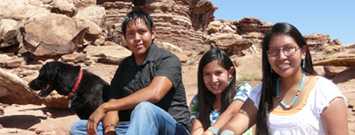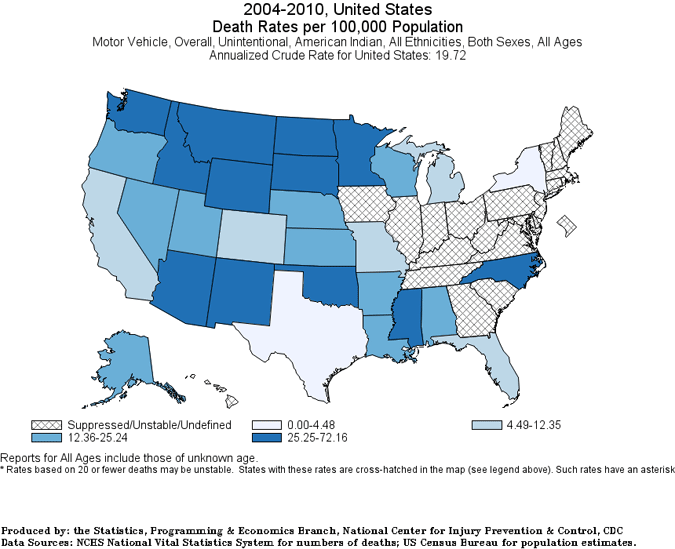Tribal Road Safety
 CDC’s Injury Center works with tribal nations to implement motor vehicle injury prevention programs, save lives, and to reduce injuries. Learn more about American Indians’/Alaska Natives’ risks on the road and how crash-related injuries and deaths among members of tribal nations can be prevented.
CDC’s Injury Center works with tribal nations to implement motor vehicle injury prevention programs, save lives, and to reduce injuries. Learn more about American Indians’/Alaska Natives’ risks on the road and how crash-related injuries and deaths among members of tribal nations can be prevented.
Did you know?
From 2004–2010, the five states with the highest motor vehicle-related death rate among American Indians/Alaska Natives were Wyoming (72 deaths per 100,000 population), South Dakota (59 deaths per 100,000 population), Montana and North Dakota (56 deaths per 100,000 population), and Arizona (45 deaths per 100,000 population).
Motor vehicle related deaths rates per 100,000 population – American Indians/Alaska Natives, all ages, United States, 2004–2010.

Click for larger version (PDF)
*Rates based on 20 or fewer deaths are unreliable and therefore suppressed.
The Reality
- Motor vehicle crashes are a leading cause of death for American Indians/Alaska Natives (AI/AN) aged 1–44. On average, 2 AI/AN are killed every day in motor vehicle crashes.
- AI/AN are injured or killed in motor vehicle crashes at much higher rates than other Americans.
- AI/AN have the highest alcohol-related motor vehicle death rates of all racial groups.
- AI/AN car seat, booster seat, and seat belt use rates are much lower than national rates. Fifty-six percent of occupants who died in motor vehicle crashes were not wearing seat belts at the time of the crash.
- In 2016, seatbelt use rates in 17 reservation communities ranged from a low of 49 percent to a high of 93 percent.
What Can Be Done?
Thankfully, there are proven strategies to reduce crash-related injuries and deaths among members of tribal nations.
- Know how to use car seats, booster seats, and seat belts and use them on every trip (see Find the Right Seat chart).
- Choose not to drink and drive. Stop friends and family from drinking and driving.
- Share what works with the community such as primary seatbelt laws, child safety seat laws that cover children through at least age 8, .08 BAC laws and zero tolerance laws for those under age 21, and educational and media campaigns along with improved collaboration with law enforcement.
*Additional strategies and resources are available at www.cdc.gov/Motorvehiclesafety/native.
What’s Working?
CDC’s Injury Center funded several tribes to tailor, implement, and evaluate evidence-based interventions to reduce motor vehicle-related injury and death in their communities. The following programs were successful at decreasing drinking and driving and at increasing both seat belt use and child safety seat use:
-
Decreasing alcohol impaired driving:
CDC funded the San Carlos Apache Tribal Motor Vehicle Injury Prevention program to implement media campaigns to promote safe driving, improve coordination with law enforcement to strengthen the use of sobriety checkpoints, and to sponsor events to increase awareness about the dangers of alcohol-impaired driving. Increased attention to and heightened level of support for this public health issue contributed to large-scale changes to benefit the community as a whole. For instance, members of the San Carlos tribe have seen a 40 percent increase in seat belt use, a 25 percent decrease in motor vehicle crashes, and an increase in total DUI arrests following implementation of a newly enacted primary seat belt law and a .08 blood alcohol concentration (BAC) law. -
Increasing child safety seat use:
CDC funded the Yurok Tribe in California to implement the California Rural Indian Health Board’s Buckle Up Yurok Program, which was comprised of community education clinics, a media campaign, safety seat checks to encourage child safety seat use, and the distribution of more than 250 car seats. As a result, from 2011–2014, child safety seat use increased 34 percent (from 53 percent to 71 percent). In addition, tribal members passed new primary seat belt and child safety seat laws in 2012, furthering protection for both child and adult motor vehicle occupants. -
 Increasing seat belt use:
Increasing seat belt use:
CDC funding of the Hopi Tribe allowed for improved collaboration with law enforcement to strengthen existing seat belt law. A successful media campaign raised awareness among tribal members about the importance of buckling up. The campaign, educational efforts, and improved enforcement of the seat belt law led to an increase of 33 percent (from 42 percent to 53 percent) in driver seat belt use and an increase of 50 percent (from 30 percent to 45 percent) in passenger seat belt use between 2011 and 2014.
Lessons learned from these programs will allow for improved implementation as strategies are disseminated to other AI/AN communities.
More Information
More Information
- CDC Tribal Motor Vehicle Safety Facts
- CDC Motor Vehicle Motor Vehicle Safety
- CDC Menu of Selected Tribal Laws Related to Motor Vehicle Safety
- Bureau of Indian Affairs (BIA) Division of Transportation
- Native American Heritage Month
- Indian Health Service – Injury Prevention
- The Guide to Community Preventive Services: Evidence-based Motor Vehicle Injury Prevention Programs
- UNC Injury Prevention Research Center
- Page last reviewed: November 10, 2016
- Page last updated: November 14, 2016
- Content source:
- National Center for Injury Prevention and Control
- Page maintained by: Office of the Associate Director for Communication, Digital Media Branch, Division of Public Affairs




 ShareCompartir
ShareCompartir